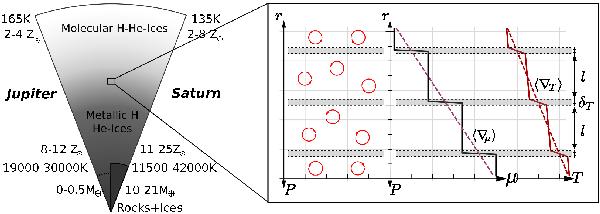Fig. 2

Schematic representation of the interiors of Jupiter and Saturn, according to the present study, and of layered convection, with the resulting compositional and thermal radial profiles. The abundance of metals is constant within the well mixed convective cells of size l, and undergoes a steep variation within the diffusive interfaces of thermal size δT (gray regions). Thanks to this steep gradient, these interfaces are stable against convection and energy and matter are transported therein by diffusive processes. Because the size of these layers is very small compared with the size of the planet, the mean thermal and compositional gradients ( ⟨ ∇T ⟩ and ⟨ ∇μ ⟩ ) can be used in good approximation to infer the planet’s overall structure.
Current usage metrics show cumulative count of Article Views (full-text article views including HTML views, PDF and ePub downloads, according to the available data) and Abstracts Views on Vision4Press platform.
Data correspond to usage on the plateform after 2015. The current usage metrics is available 48-96 hours after online publication and is updated daily on week days.
Initial download of the metrics may take a while.


